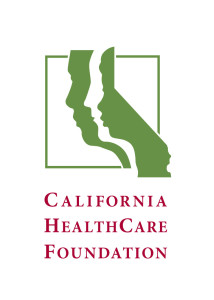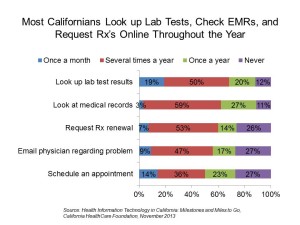 If Californians represent their American peers, then most people in the U.S. want to access their health information online, based on findings in Health Information Technology in California: Milestones and Miles to Go, a report from California HealthCare Foundation published on 6 November 2013.
If Californians represent their American peers, then most people in the U.S. want to access their health information online, based on findings in Health Information Technology in California: Milestones and Miles to Go, a report from California HealthCare Foundation published on 6 November 2013.
Interviews among 319 California residents conducted in February 2013 found that:
- 3 in 4 people believe an electronic health record (EHR) is a valuable tracking tool
- 85% of people say doctors should have access to a patient’s personal health information – but
- 49% say “my health records are for my own use and should not be provided to other parties”
- Only 37% of people believe their insurer should have access to information in the EHR.
The most trusted sources of health information online were said to be medical websites like WebMD and Medscape (among others), with 62% of people trusting these sites tied with health plans sites, closely followed by YouTube (at 60% of people trusting the channel). 42% of people trust search engines like Google, Yahoo! or Bing for health information, and then health information is hospital websites, garnering 33% of people trusting them. 40% of people in this survey of Californians said they don’t use any online sources for seeking health information.
 Of over one-half of Californians who have EHR access, most look up lab test results, check out their medical records, and request a prescription drug renewal throughout the year. Most of these people also email their patients at least once a year, shown in the bar chart.
Of over one-half of Californians who have EHR access, most look up lab test results, check out their medical records, and request a prescription drug renewal throughout the year. Most of these people also email their patients at least once a year, shown in the bar chart.
Turning from consumers to health providers, over 3/4 of California doctors used an EHR in 2012, similar to the overall U.S. rate of EHR adoption among physicians. Size matters when it comes to EHR adoption: a greater number of larger practices have adopted EHRs than smaller practices. Whereas 4 in 5 practices with over 10 physicians are using EHRs in California, 4 in 10 solo practitioners, and 6 in 10 doctors working in 2-9 physician practices, are using EHRs.
Health Populi’s Hot Points: As CHCF coins in the title the report, there are “milestones and miles to go” when it comes to health IT use in the State of California.
The state in fact is not wholly representative of the U.S. in aggregate in that it is the site of the most health-IT advanced organization in the country: Kaiser-Permanente. I wrote about Kaiser’s commitment to health IT in The Story of Kaiser Permanente’s EHR here on Health Populi in September 2010. What Kaiser learned after a decade of experience in health IT and $millions of investment and staff time was that successful implementation of an EHR wasn’t about the technology: it had more to do with leadership, collaboration among multi-disciplinary team members, and a group’s vision to transform health care for the betterment of patients and the organization, as well.
These are the socio-cultural requirements of health engagement for both consumers and providers – which aren’t really captured in Meaningful Use incentives. Now that EHRs have proliferated across the country, it behooves us to keep Kaiser’s lessons learned front-of-mind as we work to maximize the up-front investment in EHRs. In particular, it’s encouraging to see that patients-people-consumers want access to their electronic health information. But what do people really want to see in the EHR or patient portal? We know people like looking at lab values as soon as they’re available after they get their test done. What else has value for real people in that EHR personal health data goldmine? This is The Question for user-centered design advocates when it comes to how to design a patient portal and tools to drive peoples’ engagement in their health and health information. For one of my favorite places to learn about user-centered design in personal health data, check out Juhan Sonin’s work at MIT to get smarter.




 Thank you, Trey Rawles of @Optum, for including me on
Thank you, Trey Rawles of @Optum, for including me on  I was invited to be a Judge for the upcoming
I was invited to be a Judge for the upcoming  For the past 15 years,
For the past 15 years,